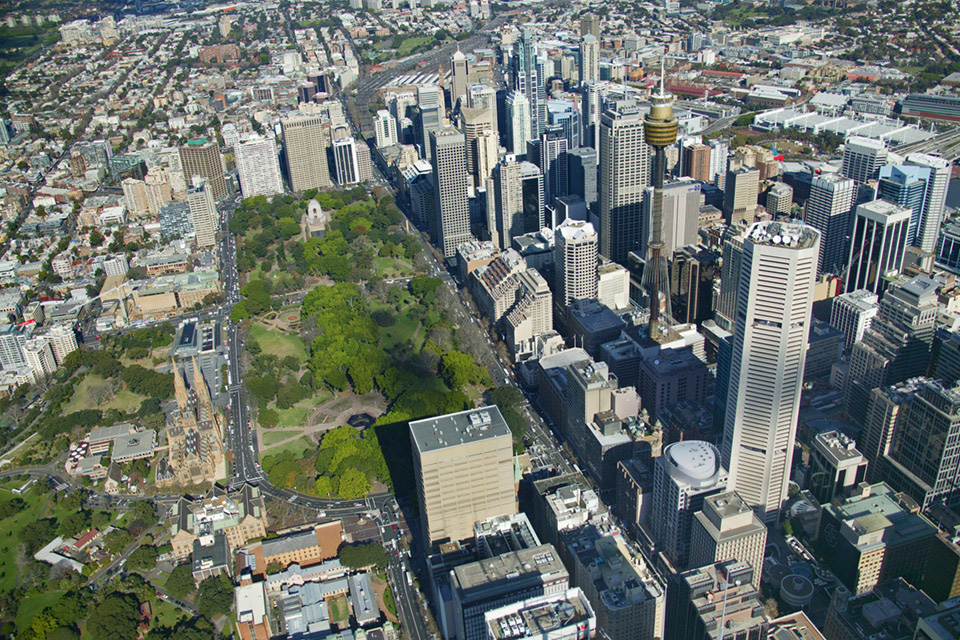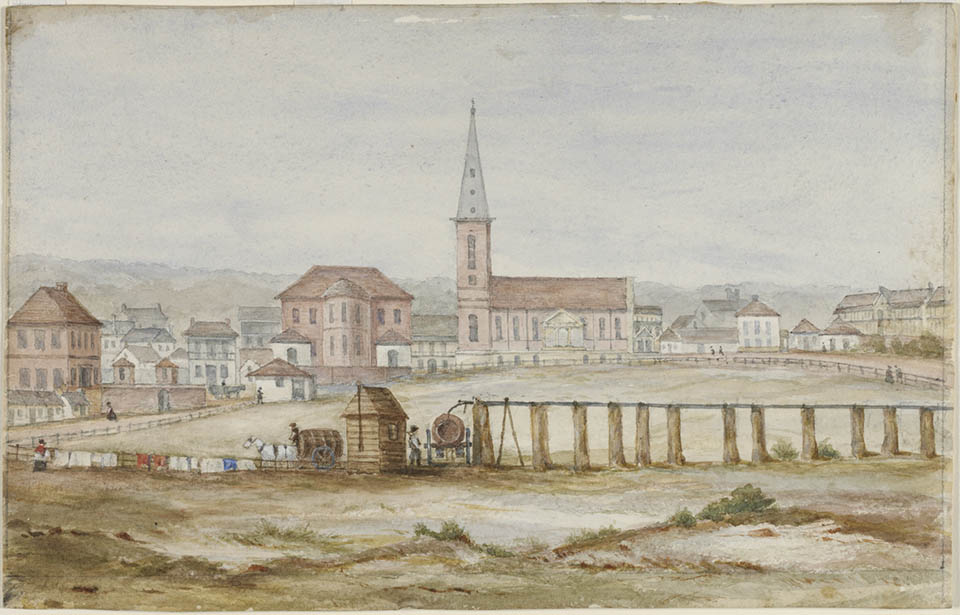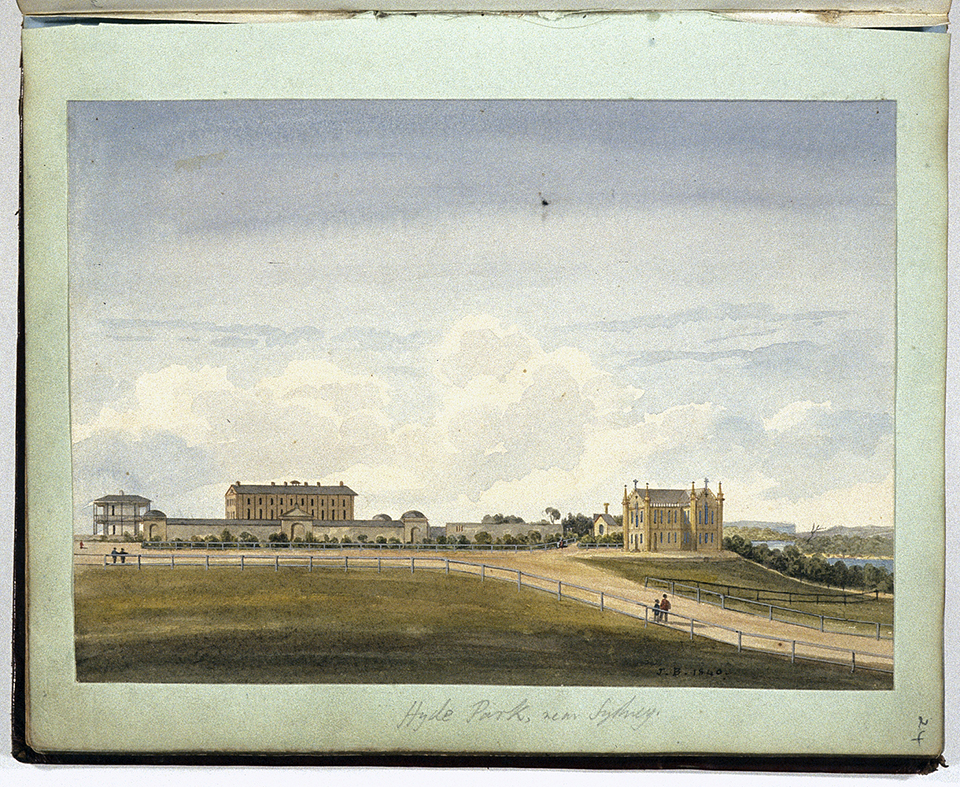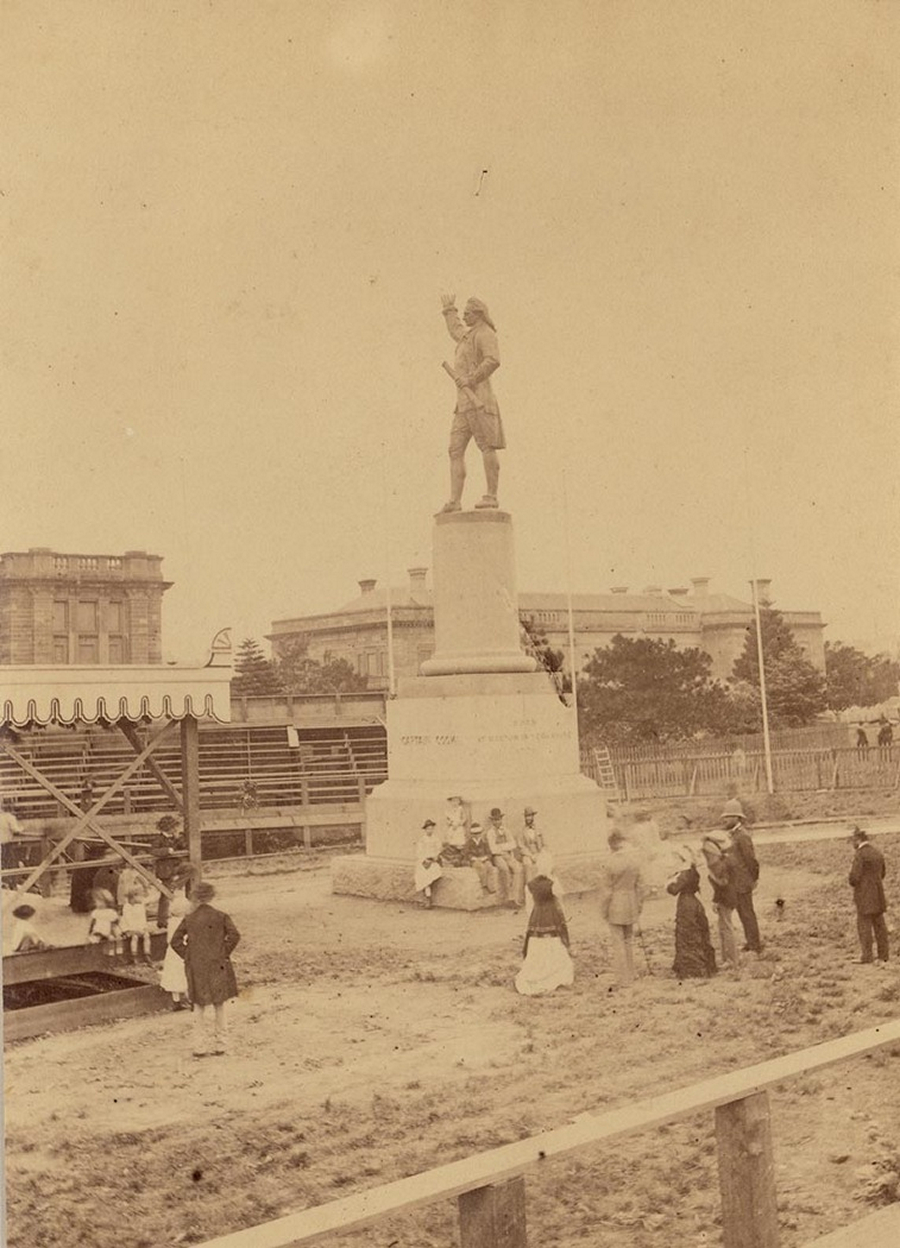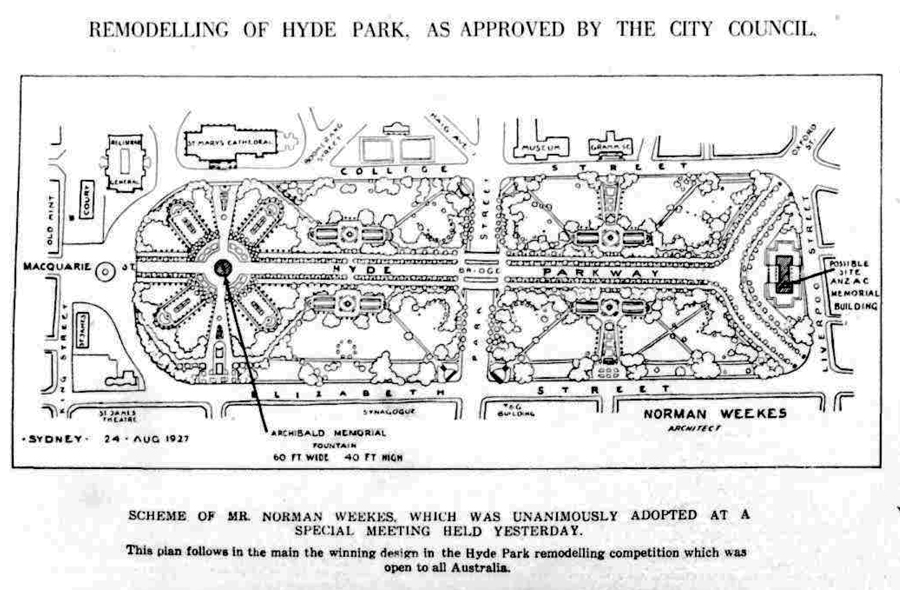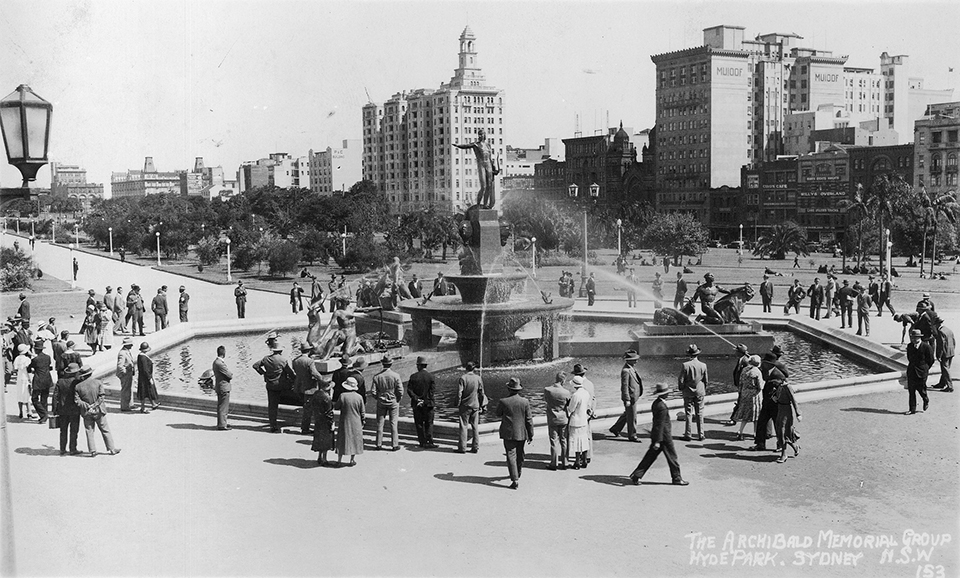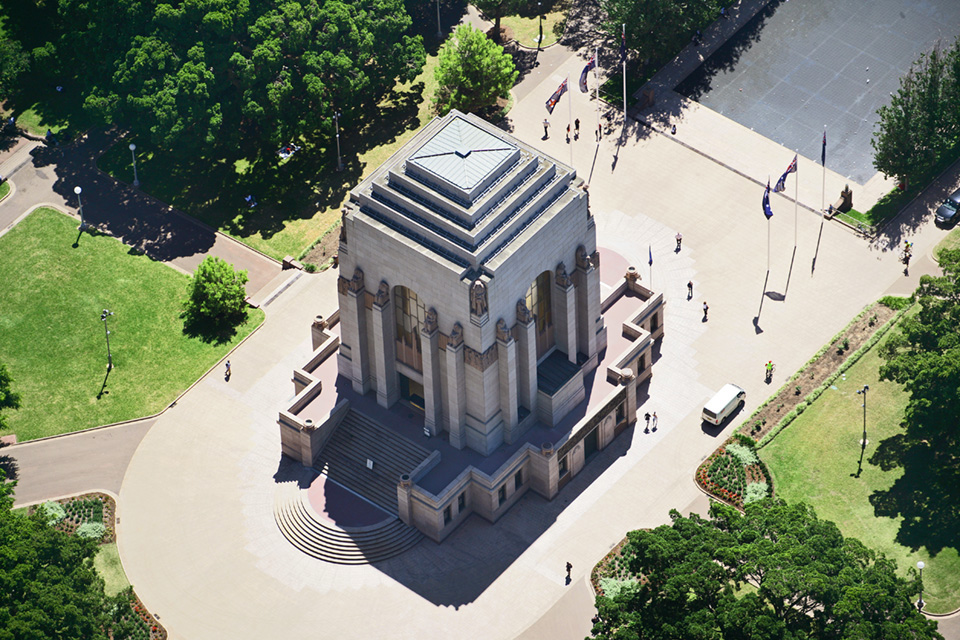The Dictionary of Sydney was archived in 2021.
Hyde Park
Citation
Persistent URL for this entry
To cite this entry in text
To cite this entry in a Wikipedia footnote citation
To cite this entry as a Wikipedia External link
Hyde Park
[media]Parks are part of what defines great cities, providing a natural oasis among the traffic and pedestrian bustle, a place for recreation and relaxation, and a focus for cultural activities and community events. Hyde Park, bounded by Elizabeth, Liverpool and College streets and St James and Prince Albert roads in central Sydney, is the oldest and most important park in Sydney. It is intensively used for strolling and short cuts, meeting and lunching, public gatherings and community events.
Today its central shaded promenade under the avenue of fig trees links the War Memorial and Archibald Fountain and provides openings into garden areas which contain many other monuments to events and people. It provides leafy vistas from the business district to architectural features such as St Mary's Cathedral, the Australian Museum and Sydney Grammar School.
Hyde Park racecourse
[media]Hyde Park is in the area reserved by Governor Phillip in 1792 for the use of the town of Sydney, on an elevated and comparatively level site adjacent to the town. It was used as a common (for gathering firewood and grazing animals) until its proclamation by Governor Macquarie in 1810. Although architect Francis Greenway envisaged it as the 'grand quadrangle' of a neoclassical town plan, Hyde Park's first use was as a course for horseracing. By the 1820s it had become a popular venue for cricket matches and informal children's games.
[media]In the 1830s Governor Darling proposed to sell off the park for houses, but his successor Governor Bourke decided against this plan and reaffirmed its status as a park. College Street was built in 1832 dividing off part of Hyde Park, in the area which later became Cook + Phillip Park. In 1837 a new water supply known as Busby's bore brought water to Hyde Park where a raised pipe was used to fill the town's water carts.
The park is planted
[media]With the construction of Sydney College (1832) and the Australian Museum (1849–51) in College Street, and the nearby Lyons Terrace (1841) in Liverpool Street, the area around the southern end of Hyde Park attracted significant and imposing buildings which increased the park's importance as a planned open space, as envisaged by Francis Greenway. The park remained without grass or trees until 1854, when the Hyde Park Improvement Committee was established. The cricket ground was moved to the Domain and the park was formalised with paths and plantings.
Civic monuments and unsavoury activities
[media]Civic monuments were also installed in the park. The first, in 1857, was an obelisk facing Bathurst Street. The obelisk is irreverently known as 'George Thornton's scent bottle' and is in fact an air outlet for the underground sewer, cleverly disguised as a full-size replica of Cleopatra's Needle (the Egyptian antiquity now displayed in London).
The next monument was a bronze statue of Queen Victoria's husband, Prince Albert, which was erected in 1866, five years after his death. This statue was moved to the Botanic Gardens in 1922, and relocated to the area in front of Hyde Park Barracks in 1987.
A [media]statue of Captain James Cook, the English explorer of Australia's east coast, was erected in 1879 to mark the centenary of his death. It stands near the corner of Park and College streets, the highest point in the park. Its sculptor was Thomas Woolmer who was prominent in the English Pre-Raphaelite movement and spent several years in Australia.
During the 1850s, with the coming of responsible government, Hyde Park became a venue for Sunday oratory on political and civic topics, and later, election meetings. It was also used for processions and official gatherings such as the ball to welcome Queen Victoria's son, Prince Alfred, the Duke of Edinburgh, in 1868.
The park's nineteenth century layout featured straight paths rather than curved ones, with the central avenue of Moreton Bay fig trees continuing the line of Macquarie Street. Elsewhere, lawns were interspersed with clumps of trees and shrubs, water features and a bandstand.
The sandstone Frazer Fountain on the College Street frontage opposite Sydney Grammar School is one of two donated by John Frazer, merchant and Member of the Legislative Council. It has been moved three times since it was first installed in the park in 1881. A bronze statue of William Bede Dalley stands at the northern end of the park near Prince Albert Road. It was erected by public subscription in 1897 to commemorate the populist politician who lived from 1831 to 1888.
By the late nineteenth century, Hyde Park at night had acquired a somewhat unsavoury reputation. It was associated with prostitution and other illicit activities, especially around its drinking fountains, which had become popular as 'pick-up' places.
The park was handed to Sydney City Council in 1904 and a program of upgrading began. Sydney's first women's public lavatory was built in 1910 in the park near the corner of Park and Elizabeth streets. It was considered a failure by council due to low usage and was replaced in 1955 by the Hyde Park Family Centre, providing facilities including child care for women and children visiting the city. The centre was demolished and the area grassed over in 2000.
The coming of the railway demands a new design
Much of the council's improvement and landscaping was swept away with the coming of the City Circle railway line in the 1920s. The whole park was dug up to build the lines, and two stations (St James and Museum) were located within it. Work began in 1919 with the felling of the fig trees, and it was 1926 before reconstruction of the park could begin.
[media]The 1926 design competition for Hyde Park was won by Norman Weekes, an engineer who was influenced by the City Beautiful movement. Weekes's design was heavily modified by the assessment committee, although the basic work of importing fertile soil was the first priority.
As the re-establishment of the park began, its two major monuments were erected. At the northern end of the park the Archibald Fountain was completed and installed in 1932, while the Anzac Memorial was opened in 1934 at the Liverpool Street end of the park.
The Archibald Fountain and the Anzac War Memorial
JF Archibald, founder of The Bulletin magazine [media]who died in 1919, left money in his estate for a fountain to commemorate the association of France and Australia in World War I. The fountain was designed by François Sicard and completed in 1932. The area around it was, for some decades, a popular homosexual cruising ground. The Archibald Fountain with its spectacular fan of water and sculpted allegorical figures is one of the most photographed sites in Sydney.
[media]At the opposite end of the park is the Anzac Memorial to Australia's World War I soldiers, which was designed by Bruce Dellit, with sculptures by Rayner Hoff. It was opened in 1934 and consists of an Art Deco ziggurat in red granite. In front of the memorial along the line of the park's central avenue is the Pool of Reflection.
Another reminder of World War I is the German gun which stands at the south-east corner of the park facing up Oxford Street. It is a four-inch naval gun from the German cruiser SMS Emden which was sunk off the Cocos Islands by HMAS Sydney on 9 November 1914, the first Australian naval victory. It was installed here in 1917.
The Oddfellows Memorial is an elaborate drinking fountain on the corner of Park and Elizabeth streets. It commemorates members of the Grand United Order of Oddfellows who served and died in World War I. Nearby a reminder of the era of trams is the wooden ticket office which has been recycled as a refreshment kiosk.
In the 1950s, as the replanted trees matured, more changes were made to the park, with the demolition of the bandstand near the corner of Park and College streets and its replacement by the Sandringham Garden.
This formal terraced garden was designed by Ilmar Berzins, the first qualified landscape architect in Australia. It is a memorial to kings George V and George VI and was opened by the Queen during her first visit to Australia in 1954. It is named after the royal family's residence in Norfolk, England.
In 1964 the Nagoya Gardens were built at the northern end of the park, and the giant chess board near St James station was installed in 1972. The Walker Fountain, erected in 1961 facing Elizabeth Street, was presented by the family of Frederic Joseph Walker to commemorate farming pioneers of Australia and was sculpted by Gerard Havekes.
References
City of Sydney Council, 'City of Sydney Hyde Park Tree Management Plan', the council, Sydney, 2006
Council of the City of Sydney, 'Hyde Park Plan of Management and Master Plan', the council, Sydney, 1989
Clive Faro, Street Seen: A History of Oxford Street, Melbourne University Press, Melbourne, 2000
Ian Kirk, 'Heritage Assessment Report and Heritage Impact Statement of Hyde Park Family Centre, 55 Park Street, Sydney', the author, Five Dock NSW, 1999
McDonald McPhee Pty Ltd, 'Hyde Park South Conservation Plans for Culturally Significant Items', the author, Balmain NSW, 1990
New South Wales Department of Public Works and Services State Projects Heritage Group, 'Anzac Memorial Proposed Vertical Lift Screens and Roof Repair Works: Heritage Impact Statement', the author, Sydney, 1999
Helen Proudfoot, 'Hyde Park, Sydney: Statement of Significance and Historical Analysis', the author, Roseville NSW, 1987



